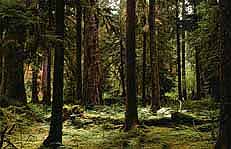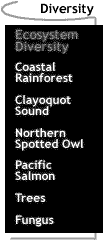Diversity: Ecosystem Diversity

At left: An open space caused by a
blow-down of trees in the Hoh Rain Forest, Washington. Photo:
Ed Shay
Three Levels of Biodiversity
In his book Ancient Forests of the Pacific
Northwest, Elliott Norse identifies three levels of biological
diversity.
1) There is species diversity, the kind that we are most familiar with. It is
represented by the incredible variety of different species on the planet,
2) Within any species, there is genetic diversity. This is the variety of combinations
possible at the molecular level and is represented by all the possibilities in the coding
of the very complex DNA molecule. That gives rise to all the variations in colors or size
or all the other slight differences that make individuals within the particular species,
3) The third level of biodiversity is ecosystem diversity. An ecosystem is the result
of all the biological, climatic, geological and chemical "ingredients" in a
particular area. This total combination of factors gives rise to certain kinds of plant
and animal communities whose needs can be met by interacting with all the other parts of
the system. (Norse, 1990). "Granted
with permission from Ancient Forests of the Pacific Northwest, E.A. Norse, © The
Wilderness Society, 1990. Published by Island Press, Washington, DC and Covelo, CA. For
more information, contact Island Press directly at 1-800-828-1302, info@islandpress.org
(E-mail), or www.islandpress.org (website)."
At right: Ferns growing on mosses
growing on a tree in the Olympic National Forest are an example of a two-layer epiphyte,
meaning a plant growing on another but deriving its moisture and nutrients from the
rain and air. Photo: Ed Shay
 The ecosystem of all forests is a complex web of
interconnected living and dead organisms. In the temperate regions, the web tends to have
high variation over space yet low density of variation of species within the same area, a
condition called beta diversity by ecologists; alpha diversity consists of high-density
variation within the same area and little change over space, a condition typical of
tropical forests. Variation from region to region of a temperate forest may be a
consequence of diverse historical conditions, such as fire, insect infestations, or other
natural changes, together with soil and altitude conditions. Marchak, M. P. (1995). Logging the globe. Montreal & Kingston,
Jamaica: McGill-Queen's University Press, p. 28. The ecosystem of all forests is a complex web of
interconnected living and dead organisms. In the temperate regions, the web tends to have
high variation over space yet low density of variation of species within the same area, a
condition called beta diversity by ecologists; alpha diversity consists of high-density
variation within the same area and little change over space, a condition typical of
tropical forests. Variation from region to region of a temperate forest may be a
consequence of diverse historical conditions, such as fire, insect infestations, or other
natural changes, together with soil and altitude conditions. Marchak, M. P. (1995). Logging the globe. Montreal & Kingston,
Jamaica: McGill-Queen's University Press, p. 28.
[ Diversity: Ecosystem Diversity / Coastal Rainforest /
Clayoquot Sound / Northern
Spotted Owl /
Pacific Salmon / Trees / Fungus ]
[ Ecosystem Flexibility ] [ Natural & Human Disturbance ] [ Logging ]
[ Tree Farming ] [ Precipitation
& Water Supply ] [ Researchers
]
[ Glossary
] [ Related Links
]
[ References
] [ PBL Model
]
[ Home
] [ Teacher
Pages ] [ Modules
& Activities ] |




